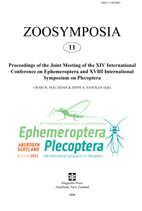Abstract
We contribute new information on the taxonomy and biology of two recently described Balkan endemic stonefly species of the genus Isoperla Banks, 1906 (Plecoptera: Perlodidae). The hitherto unknown larva of Isoperla pesici Murányi, 2011 can be distinguished from related species on the basis of more laterally positioned abdominal stripes, and the long hairs on the apical half of the cerci. This species has a wide distribution in the Central Balkans, and we add six new localities, including the first record from Albania. It emerges from late spring to mid-summer, and occurs at low to moderately high altitudes. Isoperla pesici seems to be associated with springs, especially karst spring outlets, although it occurs in both small and large springs. The hitherto unknown larva of Isoperla citrina Murányi, 2011 is distinguished by its brown coloration with an indistinct pattern, quadrangular lacinia and lack of long hairs on the apical half of the cerci. The female lacks distinctive terminalia or egg characters and its habitus is similar to the male and sufficient to distinguish it from other known Balkan taxa. The male mating call is a sequence of beat-groups with a total duration of 3–6 s (at 22 °C); each group generally containing 3 beats, while the beat repetition pattern within beat groups is rather simple. This species is restricted to the high mountains of the western-Central Balkans, where we record four new localities, including the first record from Macedonia. It emerges from June to October, and is associated with very small creeks, lined with bushes at high elevations. Amongst the accompanying species, eleven are reported for the first time from Albania: (Brachyptera helenica Aubert, 1956, B. graeca Berthélemy, 1971, Leuctra bronislawi Sowa, 1970a, L. hirsuta Bogoecu & Tabacaru, 1960, L. hippopoides Kaçanski & Zwick, 1970, L. pseudosignifera Aubert, 1954, Protonemura hrabei Raušer, 1956, P. nitida (Pictet, 1836), Nemurella pictetii (Klapálek, 1900), Chloroperla russevi Braasch, 1969 and Siphonoperla neglecta (Rostock, 1881)), while one from Macedonia (Nemoura caligula Zwick, 1978) and Leuctra pseudohippopus Raušer, 1965 is reported from outside the Moesian ranges for the first time.

